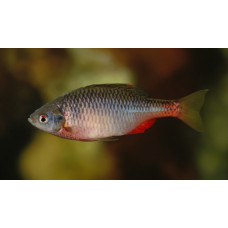Latin name
Rhodeus sericeus
Other name
Bitterling
Identification
The Amur bitterling is a small fish with a deep, laterally compressed body, large scales, and a very short lateral line. The pores of the lateral line end within the first ten scales (4–10). Vertebrae: 34-38.
Features of Fish Fins
Dorsal spines (total): 3
Dorsal soft rays (total): 8 - 10
Anal spines: 3
Anal soft rays: 8 - 10
The dorsal fin is elongated.
Coloration
Males develop more vibrant colors during the spawning season. Their scales take on a pinkish-pearlescent hue, small epithelial tubercles (breeding tubercles) appear on the head, and the fin colors become more intense.
Distribution
Its native range includes the Amur River basin, the Dnieper River, Southern Primorye, and Sakhalin Island. In Europe, its European subspecies, Rhodeus sericeus amarus (also known as Rhodeus amarus), is found in the basins of the Black and Caspian Seas, as well as in France and Germany.
Habitat
A freshwater, benthopelagic species. pH range: 5.8 - 6.3. dH range: 2-3. Depth range: 0 to ? m. It prefers a temperate climate and bodies of standing or slow-moving water. It inhabits ponds, lakes, swamps, and muddy or sandy backwaters of rivers.
Size
The maximum recorded length for males of this species is 11.0 cm. Maximum reported age: 5 years.
Behavior
The female Amur bitterling lays its eggs inside the mantle cavity of freshwater Bivalves primarily Anodonta and less frequently Unio. To accomplish this, she develops a long ovipositor prior to spawning, which she inserts between the Bivalvia's shells. Inside the Anodonta, the tiny eggs are completely protected from predators. Furthermore, Anodonta will move away from areas that are drying out, thereby saving the immobile eggs from certain death.
The larvae that hatch from the eggs do not immediately leave the hospitable shelter of the Anodonta. It is within this protective environment that they transform into fry, spending several more weeks between the shells.
Incidentally, the Anodonta readily receive the Amur bitterling. This relationship is highly advantageous for the Bivalvia. When the young bitterlings eventually depart their temporary host, the Anodonta own larval offspring, called glochidia, firmly attach to the fish. The fish then act as dispersal agents, carrying the offspring of the relatively immobile Anodonta throughout the entire water body. In this way, Anodonta avoids local overpopulation and colonizes new territories.
Food and Feeding Habits
Its diet consists primarily of plant matter, such as filamentous algae and diatoms, which likely impart a slightly bitter taste to its flesh.
Reproduction
They reach sexual maturity in their second year, at a body length of 3–4 cm. Fecundity is relatively low, with 220–280 eggs. Spawning occurs in batches, with up to 5 eggs laid at a time. The eggs develop under the protection of the mussel's sturdy shell.
Fishing
This fish species has no commercial value.
Relationship with Humans
Harmless. It is an active and attractive fish that adapts well to cold-water aquariums and serves as one of its best ornaments.
| Classification | |
| Phylum | Chordata |
| Class | Actinopterygii |
| Squad | Cypriniformes |
| Family | Acheilognathidae |
| Genus | Rhodeus |
| Species | R. sericeus |
| Features | |
| Conservation status | Least Concern |
| Habitat | Pelagic |
| Life span, years | 5 |
| Maximum body weight, kg | No information |
| Maximum length, cm | 11 |
| Sailing speed, m/s | No information |
| Threat to people | Edible |
| Way of eating | Algivore |
Amur bitterling
Tags: amur bitterling

